
© Kevin Yatarola. (Click image for larger version)
Israel Galván
La Curva
Part of Flamenco Festival USA 2014
New York, Michael Schimmel Center for the Arts
14 March 2014
Marina Harss overview of the Festival in NY Times
www.facebook.com/IsraelGlv
www.flamencofestival.org
schimmel.pace.edu
Fils Prodigue
Toward the end of Israel Galván’s solo show La Curva, the flamenco singer Inés Bacán – as solid and immutable as a rocky bluff – groans out a song, “Los Ejes de mi Carreta.” “It’s too boring, going on and on, following the track in the road, with no-one to keep you entertained,” she moans. It’s not a Spanish cante but a song by the Argentine folk-singer Atahualpa Yupanqui, a rural lament for a lonely man with nowhere to go.
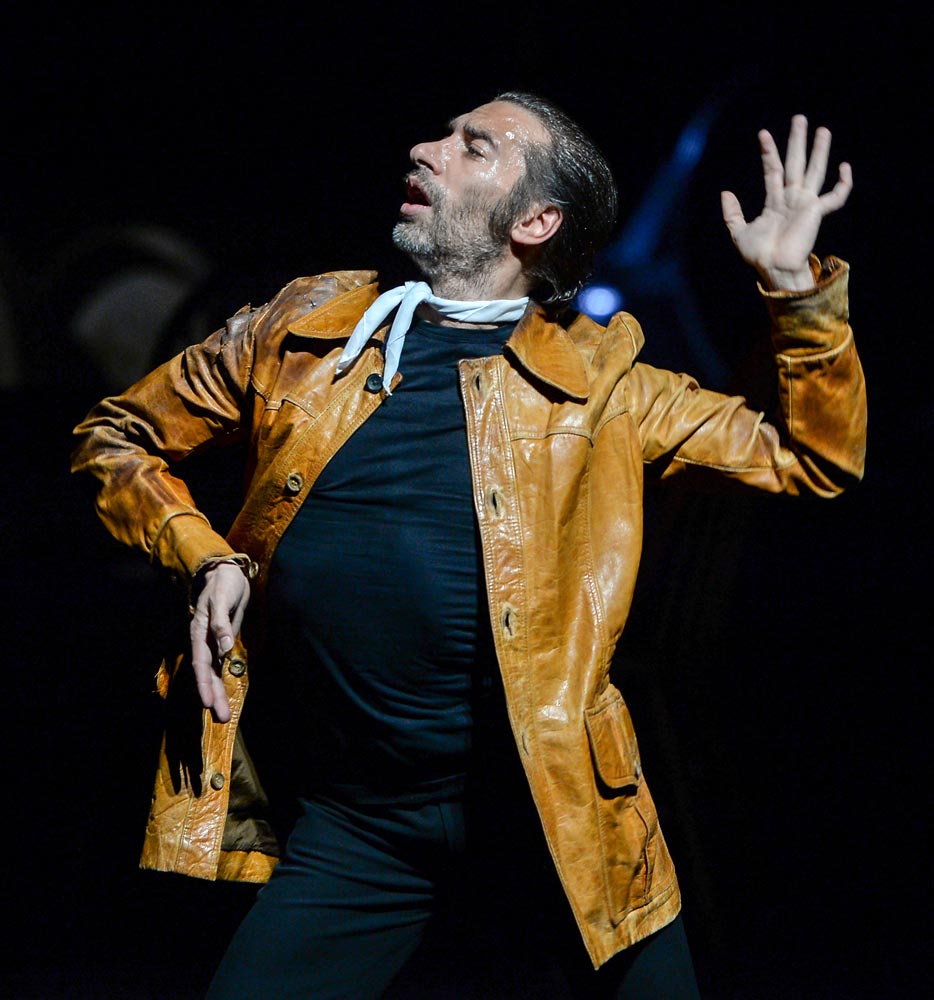
© Kevin Yatarola. (Click image for larger version)
Like the narrator in the song, Galván, who is in New York as part of the Flamenco Festival, is bored with the beaten path, hospitable as it may be to his talents. His show is in many ways a kind of conversation with the history of flamenco, whose rhythms, attitudes and technique course through his veins. Both his parents are flamenco dancers, as is his sister, but it’s not a mantle he carries lightly. “I want people to see me as something disgusting,” he said to an interviewer back in 2002. Over the course of La Curva he turns himself into a kind of defiant jester, even a grotesque figure out of Hieronymus Bosch or Kafka, head covered by his jacket, body crouched, legs skittering across the stage.
But no matter what he does, Galván can’t hide his technique, the speed with which his feet move, the clarity and articulation of every gesture and pose. His body is like a cubist deconstruction of the human form, all angles and planes. His fingers and wrists can be as rigid as hammers or as florid as Moorish arabesques. He can move a single foot with more acceleration and subtlety than most flamenco dancers can manage with two. His pivots are so swift, they create an audible wind. And he is just as precise and free when he moves backwards, with reckless speed. Unlike most flamenco dancers, whose movements dig deeply into the floor, Galván springs into the air like a coil, legs split, spinning, or feet beating in the air.
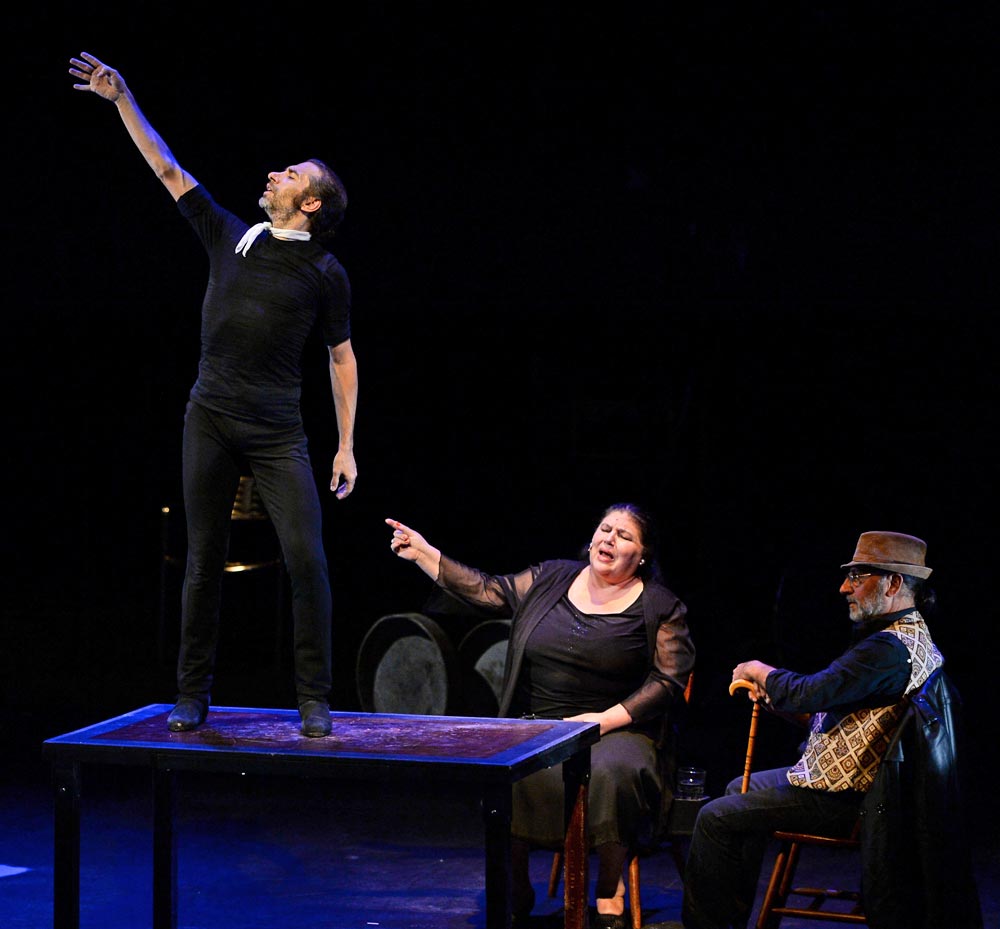
© Kevin Yatarola. (Click image for larger version)
In La Curva, he is pulled between two worlds: the European avant-garde, represented by the pianist and improviser Sylvie Courvoisier, who attacks, plucks, jabs, and caresses her ebony instrument on the left side of the stage. Courvoisier’s wide-ranging soliloquies bear traces of Debussy, John Cage, Keith Jarrett, and bebop. There is even a long quotation of The Rite of Spring, an homage to Galván’s Modernist sources of inspiration: Cubism, the Futurists, the flamenco experimentalist Vicente Escudero. And on the right, at a plain wooden table, sit Inés Bacán with her potent, uncompromising voice, and El Bobote, a low-key palmero who beats rhythms with his hands. Galván zigzags between them, sitting at the table with his flamenco family – at times they seem to be re-enacting Cézanne’s “Card Players” – then stealing away to share the piano bench with Courvoisier. Mainly, he navigates the space between them, skittering across the stage in bursts of movement or sitting, expressionless, at a midpoint in a metal chair – his own personal no-mans-land.

© Kevin Yatarola. (Click image for larger version)
For the most part, when Bacán sings, Galván is still. She hardly moves, and her style of singing is plain, unadorned, archaic. (Her singing makes one particularly aware of flamenco’s Arab influences.) Though the two hardly acknowledge each other, the connection between them is strong; she is the last person onstage, and twice he puts his hand on her shoulder. They are two of a kind. But when Courvoisier plays, the synapses in Galván’s mind seem to whizz into gear. They converse through the medium of sputtering, splintering rhythm, just as Galván communicates with Bobote in a language of tapping and rapping. At times Galván’s entire body dissolves into a fusillade of rhythms, the air crackling with salvos of footwork, vocalizations, tongue-clicking and the flickering of his fingers against his jacket, thighs, teeth, shoes.
He also makes endless jokes, holding his arms like a bow and arrow or creating a flamingo shape with his body – one leg bent at the knee – as he says, “dirty flamingo.” He does a distorted rumba, hips jutting grotesquely, and bourrées like a ballerina. Repeatedly, he hails a taxi – a joke I don’t quite understand. The humor can be bitter, too, as when he wears a chair around his neck, which makes him look like he’s being pilloried. If it all sounds a little bit schizophrenic, it is. The evening suffers from a lack of continuity and an uncompromising quality that flirts with tedium. It’s one experiment after another. There is no doubt regarding Galván’s brilliance as a dancer, but La Curva is a bit like a night of free jazz: dazzling but difficult to follow.












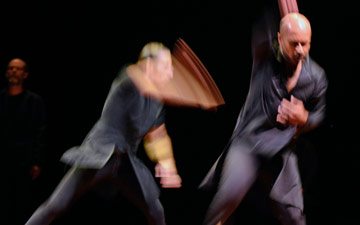


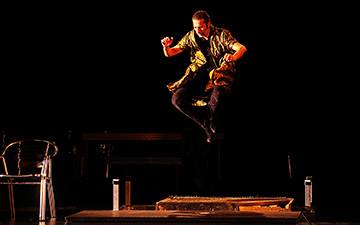
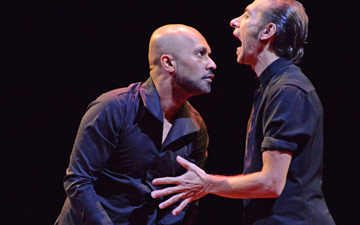
You must be logged in to post a comment.